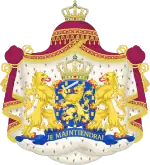National Institute for Public Health and the Environment
The National Institute for Public Health and the Environment (Dutch: Rijksinstituut voor Volksgezondheid en Milieu or simply RIVM) is a Dutch research institute that is an independent agency of the Ministry of Health, Welfare and Sport.
| Rijksinstituut voor Volksgezondheid en Milieu | |
 Coat of arms of the Netherlands | |
| Agency overview | |
|---|---|
| Jurisdiction | Kingdom of the Netherlands |
| Headquarters | Antonie van Leeuwenhoeklaan 9, Bilthoven 52.118524°N 5.189059°E |
| Employees | 1700 |
| Minister responsible |
|
| Agency executive |
|
| Parent department | Ministry of Health, Welfare and Sport |
| Website | RIVM website |
RIVM performs tasks to promote public health and a safe living environment by conducting research and collecting knowledge worldwide. The results are used to support the Government of the Netherlands in formulating its policy. RIVM's primary tasks are:[1][2]
- research
- policy support
- national coordination
- intervention programmes
- provision of reliable information to the public and to professionals working in health care about infectious diseases, the environment, nutrition and safety.
RIVM is located in Bilthoven, Utrecht and employs over 1,500 people, many of whom work in multidisciplinary fields.
History
RIVM was founded in 1910 when the Central Laboratory for Public Health was created.[3]
The present size of the institute is the result of a merger between three government institutes in 1984.[3]
RIVM has become a large, complex organisation with many different international links and a range of activities.[3]
During the Covid-19 pandemic, the RIVM was tasked with oversight of the disease and how the Dutch government would combat it. They RIVM instituted weekly counts of infected people within the nation's borders. The director of the Infectious Disease Control bureau, Jaap van Dissel, was charged with disease reduction efforts.[4]
By July 2021, the RIVM, which was a reference laboratory for the World Health Organization, recognized five types of covid test technology:[5]
- the PCR test[6]
- the loop-mediated isothermal amplification (LAMP) test
- the antigen test[7]
- the serological test[8]
- the breathalyzer test
On 13 August 2021, government announced with RIVM approval that "From 30 August social distancing will no longer be required at secondary vocational schools (MBOs), higher professional education institutions (HBOs) and universities."[9]
Organisation

The RIVM organisation consists of three domains with specific knowledge and expertise: Infectious Diseases and Vaccinology (Centre for Infectious Disease Control), Environment and Safety (including environmental incident service), Public Health and Health Services (including food and food safety).[10]
See also
- KNMI (institute)
- Netherlands Environmental Assessment Agency
- National public health institutes
Notes and references
- "National Institute of Public Health and the Environment (www.narcis.nl)".
- "About RIVM". Archived from the original on February 21, 2007.
- The Center for International Earth Science Information Network (CIESIN) (at Columbia University, New York, USA)
- "Covid-19 hospital numbers down by 27% in last week: RIVM". DutchNews. 2 June 2021.
- "Testing for COVID-19". Rijksinstituut voor Volksgezondheid en Milieu. 15 July 2021.
- https://www.rivm.nl/en/coronavirus-covid-19/testing-for-covid-19/pcr-test.
{{cite news}}: Missing or empty|title=(help) - https://www.rivm.nl/en/coronavirus-covid-19/testing-for-covid-19/antigen-test.
{{cite news}}: Missing or empty|title=(help) - https://www.rivm.nl/en/coronavirus-covid-19/testing-for-covid-19/serological-test.
{{cite news}}: Missing or empty|title=(help) - "No restrictions for on-site learning but other measures against COVID-19 extended". Government of the Netherlands. 13 August 2021.
- "Organisation | RIVM". www.rivm.nl.
Further reading
- Doornum, Gerard van; Sankaran, Neeraja; Helvoort, T. van (2020). Leeuwenhoek's legatees and Beijerinck's beneficiaries: a history of medical virology in the Netherlands (PDF). Amsterdam: Amsterdam University Press. ISBN 978-90-485-4406-6.